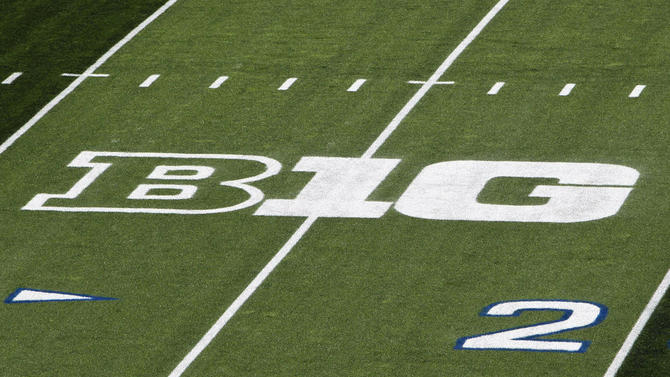So much for cable companies tightening their belts when it comes to sports television rights.
Here's today's news flash: Great content in college sports still sells, even as more Americans cut the cord with cable and satellite TV.
Two months after it was reported that the Big Ten struck a deal with Fox that would see the network paying the Big Ten $250 million per year for half of its media rights over six years, the Big Ten has now reportedly sold the other half of its rights. That second half, according to the SportsBusiness Journal, has been sold to ESPN. The Big Ten's old friend will pay the conference $190 million per year for six years.
All of this is very good for the Big Ten -- and the Power Five conferences.
The Big Ten will easily have the most lucrative television deal in place once these new deals with Fox and ESPN kick in for the 2017 season. The rest of the Power Five has now been reassured that ESPN remains an active buyer for live rights, certainly a reassuring sight to the leagues and their never-ending addiction to TV money during chaotic times for the pay-TV industry.
What does the Big Ten deal mean? Here's some analysis thanks to SBJ's fine reporting and interviews with two TV consultants: Chris Bevilacqua (helped the Big 12 and Pac-12 on media deals during realignment) and Greg Shaheen (former NCAA senior vice president who currently consults with schools, conferences and TV networks).
1. That's a lot of money. Seriously. It is. When you combine the football money with the basketball money -- CBS Sports, which employs many beautiful and intelligent people, will pay $10 million per year to continue showing Big Ten basketball -- that the Big Ten will be getting in these new deals, it all adds up to $2.64 billion.
That's right, billion with a B.
Breaking that down further, it means the Big Ten will pull in $444 million annually, and if you divide that up by 14 schools, that's roughly $31.7 million dollars per school per year.
To put that in perspective, SEC schools each received $31.2 million from the conference following the first year of the College Football Playoff. Now, that's only a $500,000 difference from that $31.7 million figure mentioned above, but that $444 million pie the Big Ten will be splitting on an annual basis isn't the only revenue the conference will be getting. That's just the money from ESPN and Fox. It doesn't include money from the Big Ten Network. Or from the CFP. Or from the bowl games.
The Big Ten Network package, which Fox owns 51 percent of through 2031-32, is estimated to have a value of $2.8 billion over the life of the 25-year deal.
The deals with ESPN and Fox are "well deserved and show the value of the Big Ten's content and the value they created by their partnership with Fox that created their network," Shaheen said. "Now you've got something in essence promoting the 24/7 channel (the Big Ten Network) when it appears on ESPN so it allows them to command similar money or greater money when they get to negotiation on their subscription fees."
Big Ten schools are about to get paid.
2. The Big Ten will still negotiate a new television deal before the other Power Five conferences do. With these new deals lasting for only six years, the Big Ten will once again sell its media rights to the highest bidder before the rest of the Power Five conferences get to. The Big Ten's new deals will expire in 2022, at the same time the NFL's television deals are expiring, and while the SEC, ACC, Big 12 and Pac-12 are all still working under their current contracts.
Big Ten commissioner Jim Delany wisely did a relatively short deal given the changing ways people now watch TV. For years, cable and satellite companies have bundled together a one-size-fits-all approach to channels. Consumers wondered why they were paying so much for stations they never watch. Cable/satellite bills kept going up and new viewing platforms emerged, such as Hulu, Amazon, Netflix, Verizon go90, Sling TV and Sony PlayStation. Consumers changed their viewing habits. Some cut cable and satellite altogether or got fewer channels as part of what's called "skinny bundles."
"I think these next several years will be a bit choppy," Bevilacqua said. "But the Big Ten is a good example that those that have high-quality content -- live sports content -- they're still going to extract real value out of the market place. It's smart for them to go shorter. In five years, they'll be back out in the market and I think it will look much different given this disruption going on. I think you'll see a different set of buyers for live sports rights in addition to the traditional buyers."
Conference realignment will likely come back on the table before existing Power Five media rights' deals expire between 2023-27. Enjoy the relative calm now. History tells us there are always moving parts when there's more money to be made."There's always a chance realignment will happen before (the Big Ten's new deal expires) and some conference has a vision that there's a better way to go at it," Shaheen said.
There's no telling how sports and cable TV, but either way, the Big Ten has put itself in a position where it can set the pace yet again when the time comes. Also, by timing it with the expiration of the NFL's deals, it's possible that networks that miss out on a deal with the NFL will want to throw a little more money the Big Ten's way to insure they don't leave empty-handed.
3. Fox will have first choice of games over ESPN. That's what happens when you're paying more money for the rights. Both networks will have the same amount of games to show (25 football, 50 basketball), but Fox will get first choice of the top games.
Via SBJ: "Before each season, the networks will pick the weeks where they get first choice of games. Fox will have the first pick every year; ESPN will have the second; Fox will have the third, and so on."
This means it's more likely than not that the annual Ohio State-Michigan game will air on Fox rather than ABC, where it's been broadcast for decades. Fox will also have the rights to the Big Ten Championship Game in December. That gives Fox the rights to arguably the Big Ten's two most attractive games. But the Big Ten will still keep a strong presence on ESPN, which went all-in with the SEC by creating the SEC Network.
4. This is not a sign that the Big 12 should expand. It's already being mentioned by some on social media that the Big Ten's new deal is just proof that the Big 12 needs to expand to increase it's television revenue. While that may seem to be the case on the surface, the truth is things just aren't that simple.
The Big Ten isn't getting this much money because it added Rutgers and Maryland. It's not getting this money because it added Nebraska. The Big Ten is getting these giant checks because it's the Big Ten. It's a conference full of schools with large enrollments, and schools that have giant alumni bases spread all across the country. That means eyeballs on television screens for Big Ten games -- more so than any other conference that is not the SEC.
So even if the Big 12 added two more teams, or hell, even four, it's just never going to be as attractive to major television networks as the Big Ten. There just aren't as many people interested in Big 12 football as there are in the Big Ten. No school that's available to the Big 12 can change that.
5. Television money is not going to dry up. Not for the people with great content. For instance, in April, CBS and Turner extended their contract for the NCAA men's basketball tournament, and they will now pay an average of $1.1 billion per year, up from more than $770 million on average.
The TV industry is undoubtedly changing. ESPN lost seven million subscribers in the past two years, even causing the SEC to answer some media questions about its future revenue security with ESPN despite a very lucrative and long-term deal.
"I've been in this league for 40 years, been athletic director for almost 25, and I kept hearing that thing the entire time -- television bump, revenue's going to burst, this bubble's going to burst," Florida athletic director Jeremy Foley said at the SEC Spring Meetings last month. "We're blessed to be in a league with some highly successful teams across the board. There's tremendous demand to watch the SEC product. ... The world is changing, but ESPN's ability to change with it, I don't question that for a second."
That's what the Big Ten deal shows. Fox and ESPN are betting on the Big Ten's valuable football brand and evolving with how consumers watch TV. "The money doesn't dry up," Shaheen said. "It just gets reallocated toward assets and investments that have demonstrated value. It's hard to believe (cord cutting) would hurt the Power Five. The only way it hurts them is it gives someone along the way a reason to think about realigning."
Since most of the Power Five's deals are locked up long-term, Bevilacqua said it's too early to predict how other leagues' content will be viewed in the future. "Nothing leads me to believe their programming will be coveted any less," he said. "In this ecosystem, five, six seven years is a lifetime. A lot of stuff is going to happen between now and then. The pay TV system is likely to shrink, although I don't think as much as others may suggest."
6. Questions arise for how smaller conferences will get paid. This is a key question for the on-field competitive issue, especially as the costs of doing business in college sports increase with cost of attendance and other benefits for athletes.
"I'm somewhat sensitive about it because I think we're watching the business segregate," Shaheen said. "I think the layer to watch in everything is the [Group of Five] conferences, and I don't like anything artificially recapping them if something deemed catastrophic happened to them."
Take, for example, C-USA, which recently signed new deals with ESPN, CBS Sports Network, American Sports Network and beIN SPORTS. Documents obtained from Old Dominion show that each C-USA school's annual media rights payout will decrease from about $1.1 million to $200,000, according to The Virginian-Pilot.
Shaheen said the details revealed in that story were outdated and the agreements had already been recalibrated when C-USA lost Memphis and Central Florida. Television agreements typically have language allowing for increased or decreased money if the conference membership changes.
"Did [C-USA] take a bath? Yes," Shaheen said. "They didn't take the bath everybody is saying."
Still, less money is less money. "C-USA got cut off at the top and you can see the results of losing the top end of your conference," Bevilacqua said. "It's not helpful."
7. Are the athletes going to benefit? Well, not directly. Not much, at least, barring changes due to pending litigation about paying athletes. After all, there is NCAA "amateurism" to protect. There will be some benefits. Players will keep getting a couple thousand dollars through cost of attendance. Perhaps some new benefits emerge, such as the Big Ten requiring schools to provide health insurance coverage for ex-athletes who got hurt playing college sports.
Most likely, the money will go toward where it always goes: higher salaries for coaches, administrators and new staff positions; and toward shiny new facilities (some of which do indirectly help athletes).
Three years ago, as part of the Ed O'Bannon case over paying players, Delany suggested that if athletes ever share TV revenue, the Big Ten could revert to the Ivy League model with no athletic scholarships. That's not going to happen, of course. The Big Ten's latest TV deal shows why.
If the Big Ten doesn't provide athletic scholarships, someone else will to entice the best players, win games and get watched by fans. You can't put the genie back in the bottle, as Delany suggested. Even as the TV industry endures turbulent times, there's too much money at stake attached to these properties that can entertain the masses.

















